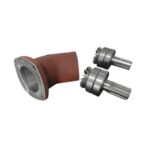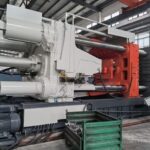Squeeze casting, also known as thixoforming or liquid metal forging, stands as a sophisticated manufacturing process that seamlessly combines the strengths of casting and forging techniques to yield high-quality metal components.

Direct vs. Indirect Squeeze Casting
Direct Squeeze Casting
Direct squeeze casting involves the direct injection of molten metal into the die cavity while applying squeezing or pressurizing force.
This simultaneous injection and pressure application ensure the production of high-quality components with minimal porosity.
Indirect Squeeze Casting
Contrarily, indirect squeeze casting entails the injection of molten metal into a pre-chamber or sleeve, followed by its transfer into the die cavity.
Pressure is applied during this process to ensure optimal component quality.
Distinguishing Factors
| Aspect | Key Points | Details |
|---|---|---|
| Injection Point | Direct casting injects molten metal directly into the die cavity. | Metal is directed straight towards the cavity for casting. |
| Indirect casting injects metal into a pre-chamber before entering the cavity. | Metal is injected into a pre-chamber or sleeve before entering the cavity. | |
| Pressure Application | Direct casting applies pressure as metal enters the die cavity. | Pressure is applied directly during metal injection into the cavity. |
| Indirect casting applies pressure in the pre-chamber or sleeve. | Pressure is applied in the pre-chamber or sleeve before metal enters the cavity. | |
| Mold Complexity | Direct casting is simpler, requiring no additional components. | No additional components like pre-chambers are needed. |
| Applications | Direct casting suits straightforward geometries. | Ideal for simple components with uncomplicated shapes. |
| Indirect casting is ideal for large or intricate components. | Suitable for complex parts or larger components. |
Manufacturing Process of Squeeze Casting: A Step-by-Step Overview
- Melting: Non-ferrous alloys are melted in a high-temperature furnace until they reach a liquid state.
- Die Preparation: A two-part mold is prepared, with one part stationary and the other movable, engraved with the desired component shape.
- Injection: Molten metal is injected directly into the die cavity or transferred to a pre-chamber before entering the cavity.
- Pressure Application: Constant pressure is applied during injection to ensure compactness and reduce porosity.
- Cooling and Solidification: Controlled cooling facilitates uniform solidification, crucial for achieving fine microstructure.
- Ejection: Once cooled, the component is ejected from the mold cavity.
- Post Processing and Quality Control: Finishing operations and rigorous quality checks are conducted to ensure adherence to standards.

Distinctive Features of Squeeze Casting
| Aspect | Key Points |
|---|---|
| Combination of Processes | Integrates casting and forging to produce complex shapes efficiently. |
| Near-Net-Shape Components | Minimizes machining requirements, reducing material waste. |
| Improved Mechanical Properties | Provides superior strength, fatigue resistance, and ductility. |
| Complex Geometrics | Enables production of intricate designs for diverse applications. |
| Thixotropic Materials Compatibility | Compatible with materials exhibiting both solid and liquid properties. |
| Cost-Effectiveness | Offers high precision at lower post-processing costs. |
Squeeze Casting vs. Liquid Forging: Contrasting Techniques
- Process Steps: While both involve injection, pressure application, and ejection, liquid forging differs in material preparation.
- Material Considerations: Squeeze casting suits non-ferrous alloys, while liquid forging is specialized for thixotropic materials.
- Precision: Squeeze casting offers superior dimensional accuracy, making it suitable for aerospace, automotive, and electronics industries.
- Applications: Liquid forging finds its niche in applications requiring thixotropic materials, such as certain automotive components.
In Conclusion
Squeeze casting emerges as a versatile and precise manufacturing method, offering strength, precision, and adaptability across various industries.
With its capability to produce near-net-shape components and its cost-effectiveness, squeeze casting remains a compelling choice for a wide array of applications.
Contact us today to discuss your project needs and receive a quote, you can trust us to deliver exceptional castings that meet your requirements.

















